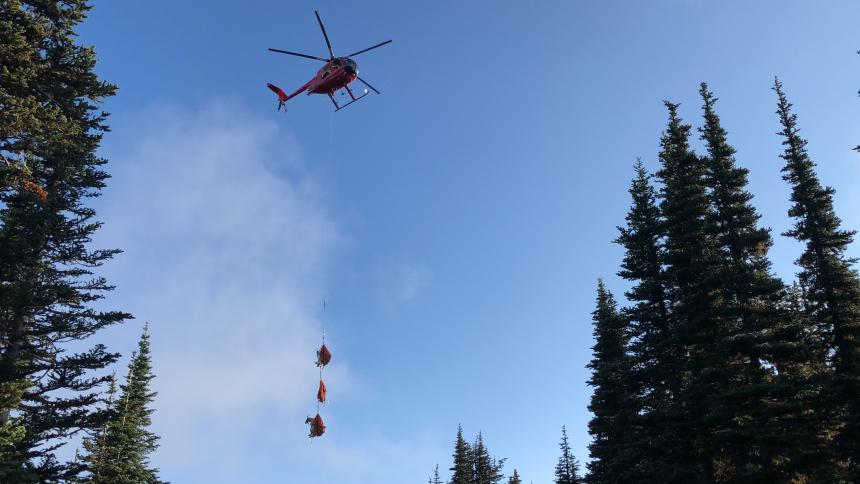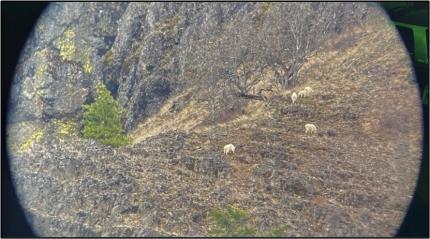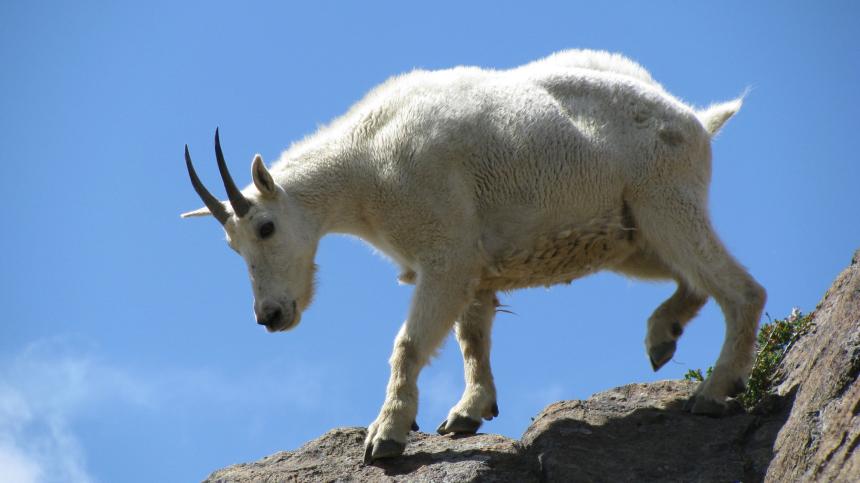Moderate-
High
The mountain goat (Oreamnos americanus), which occurs only in northwestern North America from Colorado to Alaska, is the only genus and species of its kind in the world. Its closest relatives are the chamois of Europe and the goral and serow of Asia. The domestic goat is not closely related to the mountain goat.
Washington Department of Fish and Wildlife (WDFW) biologists, federal partners, and co-manager tribes are working to better understand the declines in mountain goats in the Cascade Mountains to improve management and inform other conservation efforts like habitat enhancement.
Description and Range
Physical description
With their all white coats and shiny black horns sported by both sexes, mountain goats can be relatively easy to spot. Their horns grow from a bony core and are not shed like antlers on other ungulates. The age of a goat may be determined by counting the annual growth rings which are formed each winter except the first year. The male's horns have a wider base and curve back in a greater, more uniform arc. The female's horns tend to curve more toward the tip. Muscular development of the males' shoulders and depth of the chest are greater than that of females. Probably the best way to distinguish male and female mountain goats is their urination posture. The male stretches forward with the front legs while keeping the hind legs stationary. The female stands in place and squats on her hind legs.
At birth, young goats or kids stand about 13 inches at the shoulder and weigh 5 to 7 pounds. Yearlings may average about 45 pounds and 2-year-olds about 55 pounds. Mountain goats continue to grow through their fourth year achieving average weights of 125 to 155 pounds for females and 135 to 180 pounds for males.
Geographic range
Fewer than 3,000 mountain goats likely reside in Washington currently, the majority of those in the Cascade Mountains from the Canadian border south to around Mount Adams. There are also smaller mountain goat populations in the Blue Mountains of southeast Washington, and a transboundary population in the Selkirk Mountains of northeast Washington and northern Idaho.
Mountain goats are not native to the Olympic Peninsula and were removed from Olympic National Park and the surrounding national forest lands through translocation to the North Cascades in 2018-2022 in a project led by the National Park Service, WDFW, and Native American tribes, as well as a National Park-led lethal removal. WDFW coordinated and supported this federally-led effort.
The intent of translocation was to boost population abundance and genetic diversity of mountain goat herds in the North Cascades. 325 mountain goats were translocated from the Olympic Mountains to the North Cascades in 2018-2020.

Climate vulnerability
Sensitivity to climate change
Moderate-
High
Exposure to climate change
Moderate-
High
Regulations
Rules and seasons
The Washington Department of Fish and Wildlife (WDFW) classifies the mountain goat as a game animal. A limited number of special, once-in-a-lifetime mountain goat hunting permits are issued each year on a draw basis to hunters who apply with valid licenses and tags. The season is open from mid-September through October in selected portions of Regions 2 (Northcentral), 3 (Southcentral), 4 (North Puget Sound), and 5 (Southwest) of the Cascade Range. Mountain goats are present in all three national parks in Washington (North Cascades, Mount Rainer, Olympic), where no hunting is permitted. Mountain goats are also present in sections of Indian Reservations within Washington, including the Yakama Reservation. See the Big Game Hunting Seasons and Regulations pamphlet for additional information.
Conservation
Mountain goat populations have declined overall in Washington relative to estimated historical levels. Goat populations within the state were considered to have exceeded 10,000 animals (including those within federally-managed areas) as recently as 1961.
Hunting opportunity has decreased accordingly. Current permit levels are conservative and represent no more than four percent of mountain goat populations that are surveyed regularly and are stable or increasing. These include herds around Mt. Baker, along the lower Cascade crest, and along the north shore of Lake Chelan.

The most recent statewide estimate of mountain goats in Washington state by Washington Department of Fish and Wildlife (WDFW) was in 2012 and estimated approximately 2,800 goats and as many as 3,200.
Mountain goat populations in the North Cascades have been declining since around 2016 and are now generally doing poorly across the region both east and west of the Cascade Crest compared to historical levels.
Stable to increasing mountain goat population trends were recorded during the 2002-2015 timeframe. The more recent decline in mountain goats in the North Cascades is likely due to more severe winters and especially winters that are preceded by severe drought. In general, climate change is impacting alpine and montane environments, and species like mountain goats that inhabit these landscapes, more rapidly than other ecosystems.
WDFW and external researchers published a study in 2023 that identifies extreme environmental conditions (i.e., intense winter and drought conditions) as a major driver of mountain goat survival. “Survival of adult mountain goats in Washington: effects of season, translocation, snow, and precipitation”.
The study’s sample was primarily translocated mountain goats from the Olympic Mountains (see below), but also a small number of goats that live in the North Cascades. Generally, the study found high levels of mortality among both translocated and resident mountain goats, with higher levels of mortality among the translocated goats.
Mountain goats have naturally low reproductive rates relative to other ungulates like deer and elk. This low reproductive rate limits their ability to bounce back from population declines, especially if a decline is associated with habitat limitations.
Mountain goats live in challenging environments, both to survive and to study. They live mostly in higher elevation alpine areas, periodically moving down in altitude to take shelter in mid-elevation forests. During their time in mid-elevation forests, mountain goats may be vulnerable to predation by cougars and occasionally other carnivores.
Living with wildlife
The mountain goat breeding season occurs from mid-November through early December. Females (or nannies) do not breed until at least 2 1/2 years of age. After a gestation period of six months, kids are born in late May or early June and closely follow their mothers for the first year. Adult females rank highest in the social order. By association, kids also assume the superior status of their mothers who vigorously defend them until they are yearlings. Yearlings drop to the bottom of the social order and are forced to forage last in areas pawed out by other goats. Kid and yearling survival may be less than 50 percent depending upon the severity of the winter. If a goat survives weather, falls, and predation by cougars, eagles and other predators during its juvenile years, longevity is normally 10 to 13 years.
Female-juvenile (nursery) groups range in size from two to well over a dozen mountain goats, with some groups up to 70 animals. Large groups generally occur during early summer when goats congregate on prime feeding grounds or at mineral licks. As the summer progresses and the vegetation dries out, group size diminishes.
By the age of two, males or billies begin to disassociate themselves from nursery groups. Outside of the mating season, males tend to associate primarily with other males. Females normally inhabit the most desirable cliffs which are also often more visible and accessible than areas frequented by males. From late October to mid-December, males seek out females, so both sexes can be found together at this time of year.
Preventing conflict
Although typically shy and retiring, mountain goats can learn to approach people and become a nuisance or even potentially dangerous – all to satisfy a craving for minerals and salt.
Minerals are limited in the alpine vegetation that mountain goats consume, especially in early summer when succulent new growth is particularly low in sodium and related minerals. Many mountain goats make use of natural mineral licks in early summer to satiate their desire to supplement this element of their diet. But others learn to associate people as a source of salt through urine and sweat.
When people visit mountain goat habitat, usually on popular alpine hiking trails in national parks and other public lands, some unwittingly condition goats with their behavior. Urinating on trailside vegetation or rocks adds salt and minerals to the environment. Hand-feeding goats can provide salt and minerals in both the food offered and in the sweat on hands. When goats drawn to these sources of salt are not deterred, they become habituated to people – they lose their natural avoidance response.
Habituation of mountain goats provides opportunities to observe and photograph them at closer proximity than normal. But when goats become insistent on obtaining expected rewards, approaching and following closely, they can become at least a nuisance and potentially dangerous.

Despite their seemingly docile nature, mountain goats are aggressive with each other, using their sharp horns in such interactions. Habituation to people can produce a very dangerous situation, with goats using their horns to injure, and in extreme cases, even kill people. In 2010, a hiker in Olympic National Park died from an encounter with an aggressive mountain goat – thought to be the first such incident in Washington state.
WDFW recommends avoiding behavior in mountain goat habitat that might encourage habituation, and encourages behavior to help return already-habituated goats to their natural wariness of humans.
- Maintain a distance of at least 50 yards from mountain goats; instead of getting closer for a view or photograph, use binoculars and a telephoto camera lens
- Never offer food to mountain goats or any other wildlife
- Never urinate within 50 yards of a hiking trail
- Leave pets at home when hiking in mountain goat habitat
- Do not touch, surround, crowd, or chase a mountain goat
- Do not allow a mountain goat to approach too closely; yell with a loud voice, wave your arms or an article of clothing, and if need be, throw rocks at the goat
- Avoid hiking alone in areas where mountain goats are habituated to people; in the case of an attack, hiking partners may be able to help.
